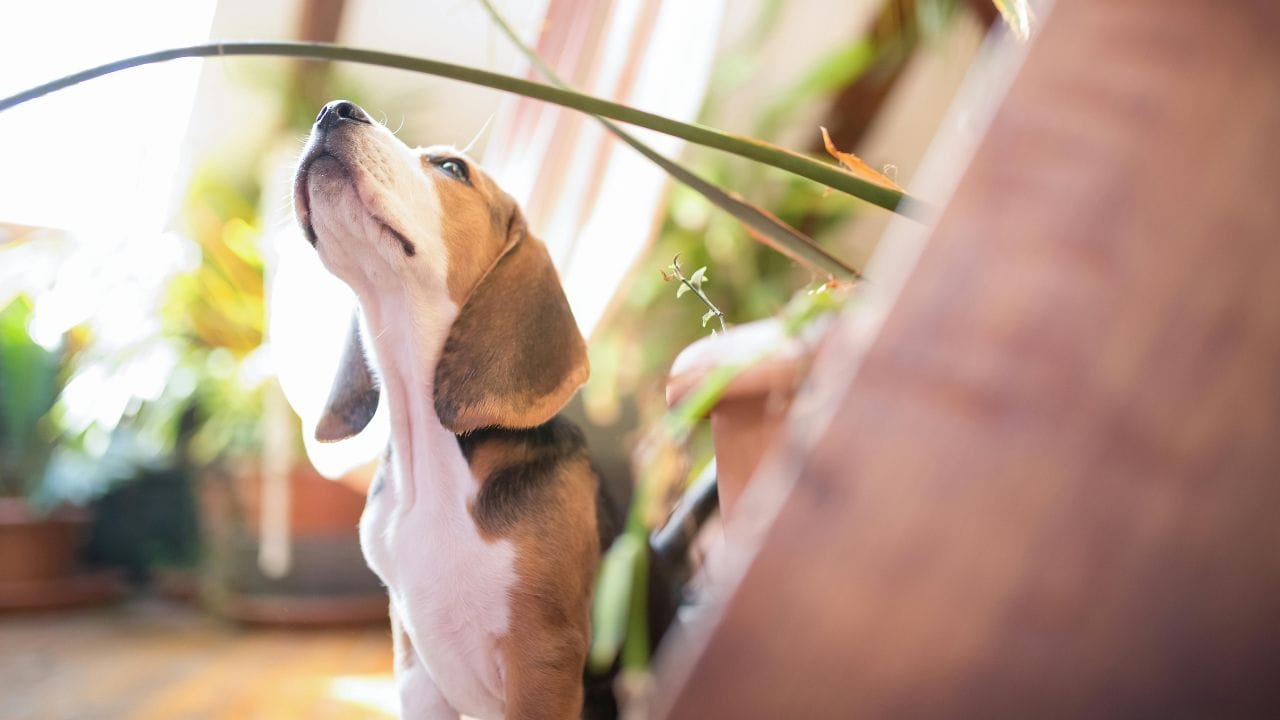Dog-Friendly Décor: The Ultimate Plant Safety Guide
You might be dog-friendly, but are your plants friendly to dogs? Let's take a closer look at toxic vs. non-toxic plants for your hotel, home, and garden.

We all have stories of curious canines ingesting things they're not supposed to. My personal favorite non-toxic incident was when my cousin's Golden Retriever, Brady, ate two entire sticks of butter, wrappers and all. Understandable, I'd say. Sometimes the butter craving is just too strong!
Our dogs can also, unfortunately, chew on and consume things that make them quite ill. One way to lessen these instances and keep a non-toxic household for our canine companions is to mind what houseplants we buy, upkeep, and decorate with. Not to mention, being aware of what common outdoor plants to steer your dog away from in the garden or on daily walks.
Since many of us (myself included) aren't well-versed enough on plant life to identify any plant species at a glance, having an identifying app like PictureThis on your phone is also a good idea and will make it easier to be fully informed about the plants, flowers, shrubs, trees, etc., in your neighborhood/backyard and whether they pose a risk to your dog.
So, without further ado, let's get into Roch's ultimate houseplant safety guide:
Highly Toxic to Dogs
These indoor and outdoor plants pose the greatest risks (i.e., organ failure, seizures, risk of fatality, etc) if ingested. Click here for the ASPCA's complete alphabetically-organized directory of 1000+ plants.
- Sago Palm (Cycas revoluta) – Can cause vomiting, diarrhea, liver failure, and even death.
- Oleander (Nerium oleander) – Extremely toxic; affects the heart and can be fatal.
- Jade Plant (Crassula ovata) – Can cause vomiting, depression, and cardiovascular collapse.
- Black Laurel (Leucothoe spp.) – Can cause weakness, low blood pressure, coma, and even death.
- Japanese Yew (Taxus cuspidata) – Highly poisonous; can cause tremors, vomiting, seizures, and heart failure.
- Autumn Crocus (Colchicum autumnale) – Can cause multi-organ damage, gastrointestinal bleeding, and respiratory failure.
- Rhododendrons – Can cause vomiting, diarrhea, weakness, coma, and cardiovascular collapse.
- Azaleas – A subspecies of Rhododendrons. Equally life-threatening.
- Daffodil (Narcissus) – The bulbs are highly toxic and can cause severe digestive distress. The larger the ingestion, the more severe the symptoms (e.g., convulsions, tremors, and cardiac arrhythmias).
- Tulips & Hyacinths – Also dangerous due to their toxic bulbs.
- Foxglove (Digitalis) – Extremely toxic to dogs and can cause heart failure.
- Lily of the Valley (Convallaria majalis) – Can lead to vomiting, heart arrhythmias, and even death.
- Tomato Plant (Leaves & Stems) (Solanum lycopersicum) – Can cause weakness, inappetence, and slow heart rate.
If you suspect your dog has ingested a toxic plant, contact your vet or a poison hotline immediately. Popular 24-hour hotlines like ASPCA Poison Control Center (888-426-4435) or the Pet Poison Helpline (855-764-7661) do charge fees for their services (often up to $100) but are well worth it when you can't reach your vet during a medical emergency.
Moderately Toxic to Dogs
Unlike those listed above, these plants are less life-threatening if ingested. However, they still cause unpleasant gastrointestinal symptoms and painful mouth irritation, which should be monitored and appropriately treated by your veterinarian.
- Aloe Vera – Can lead to vomiting, diarrhea, and lethargy. (NOTE: the gel is edible but the plant contains mildly toxic compounds).
- Asparagus Fern (Asparagus setaceus) – Dermatitis (contact rash) upon exposure. Ingestion of berries can lead to gastrointestinal distress.
- Peace Lily (Spathiphyllum) – Contains calcium oxalate crystals that can cause drooling, oral irritation, and difficulty swallowing.
- Philodendron – Can cause mouth irritation, excessive drooling, and difficulty swallowing.
- Rubber Plant (Ficus elastica) – Causes mild stomach upset and irritation.
- Bird of Paradise (Strelitzia reginae) – Can cause nausea and vomiting.
- Dracaena – Leads to vomiting, drooling, and loss of appetite.
- Caladium – Not organ toxic but can cause severe irritation in the mouth and swelling.
- Chinese Evergreen (Aglaonema) – Can cause mouth pain and digestive upset.
- ZZ Plant (Zamioculcas zamiifolia) – Can cause vomiting, diarrhea, and oral irritation.
- Snake Plant (Sansevieria trifasciata) – Can lead to nausea, vomiting, and diarrhea.
- Dumb Cane (Dieffenbachia) – Causes intense mouth irritation, drooling, swelling, etc.
- Pothos (Devil’s Ivy) (Epipremnum aureum) – Causes mouth irritation, vomiting, and difficulty swallowing.
Garden Plants at a Fido-Friendly Glance
For those with a green thumb or a passion for landscaping, here are some outdoor/garden plants (flowers and shrubs) that are non-toxic to dogs:
Flowers
- African violet
- Creeping zinnia
- Gerbera daisy
- Impatiens
- Baby's Breath
- Forsythia
- Lipstick plant
- Petunia
- Zinnia
- Sunflowers
Shrubs
- Magnolia Bush
- Mulberry Bush
- Viburnum
- Lilac
- Abelia
- Butterfly Bush
- Weigela
- Deutzia
- Dwarf Spiraea
- Blackhaw
And, Finally, Some Dog-Safe Houseplants!
Dog-friendly decor for your home sweet home or dog-friendly hotel is listed below! If you're not a very good plant parent (like me) and prefer low-maintenance plant life, check out this overview of pet-friendly succulents.
- Hens and Chicks (House Leek)
- Burro’s Tail (a succulent)
- Blue Echeveria (a succulent)
- Ponytail Palm (Beaucarnea recurvata)
- Bamboo
- Echinacea (Purple Coneflower)
- Pansies (Viola × wittrockiana)
- Boston fern (Nephrolepis exaltata)
- Baby's Tears (Soleirolia soleirolii)
- Cast iron plant (Aspidistra elatior)
- Christmas cactus (Schlumbergera spp.)
- Parlor palm (Chamaedorea elegans)
- Spider plant (Chlorophytum comosum)
- Swedish ivy (Plectranthus verticillatus)
- Watermelon Peperomia (Peperomia argyreia)
- Orchid (Phalaenopsis)
- Polka Dot Plant (Hypoestes phyllostachya)
- Snapdragons (Antirrhinum majus)
- Roses (but mind the thorns)
Stay tuned for more Roch guides on dog safety, health, and wellness.
Questions, concerns, or must-share anecdotes? Drop us a comment below!


